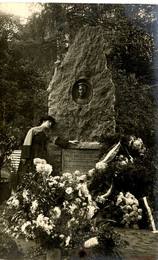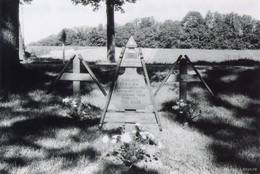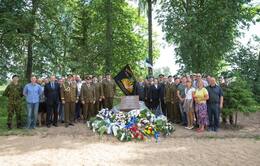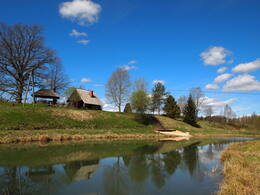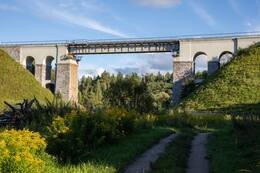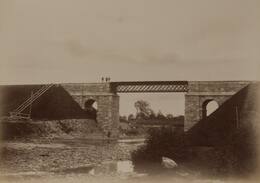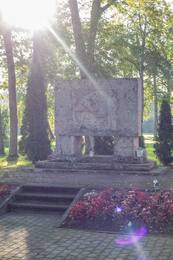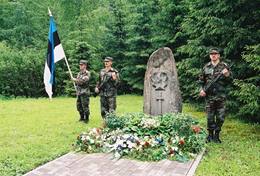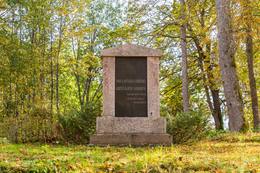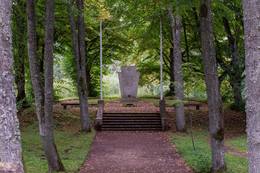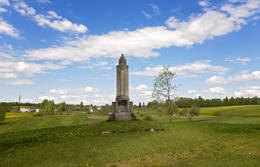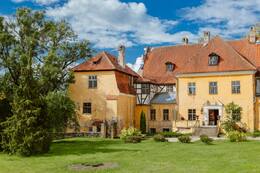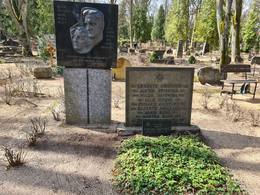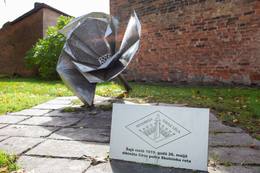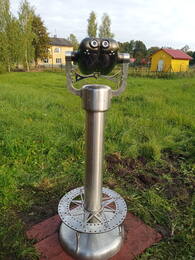Cėsių mūšis (estiškai Võnnu lahing)
I Nepriklausomybės karai
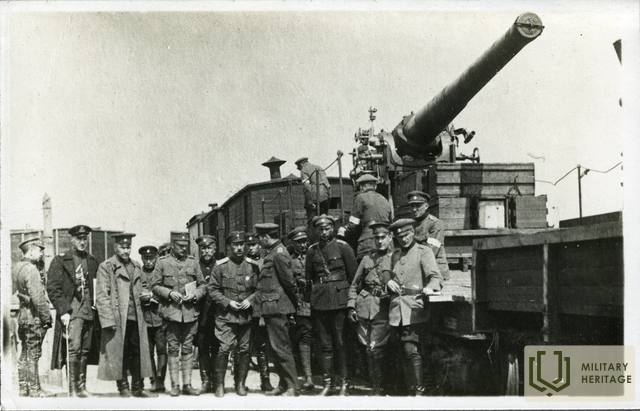
Cėsių mūšis (est. Võnnu laheng) buvo vienas iš lemiamų Latvijos nepriklausomybės karo mūšių. Estijos nepriklausomybės karo istorijoje jis žinomas kaip „Landesvero karas“. Mūšis įvyko 1919 m. birželį tarp Estijos armijos ir Šiaurės Latvijos brigados 2-ojo Cėsių pėstininkų pulko dalinių, viena vertus, ir Baltijos landesvero bei Geležinės divizijos, vadovaujamos Andrijevo Niedros, kita vertus.
1919 m. birželio pradžioje priešiškos armijos susitiko netoli Cėsių. Tuo metu mieste buvo tik 300 Krišjanio Berkio vadovaujamo 2-ojo Cėsių pulko kareivių. Iš Cėsių ir Valmieros mokyklų mokinių buvo suformuota Cėsių pulko mokinių kuopa. Birželio 6-osios naktį prasidėjo Landesvero puolimas. Iš Livu parapijos apylinkių kovos persikėlė į Cėsius. Mūšis tęsėsi iki vidurdienio, kai 2-asis Cėsių pulkas atsitraukė Raunos link. Jį pakeitė Estijos 6-asis pulkas, kuris birželio 8 d. nesėkmingai bandė atsiimti Cėsį. Birželio 10 d. buvo nutrauktos paliaubos. Birželio 19 d. dešiniajame Gaujos krante atsinaujino karo veiksmai tarp vokiečių Geležinės divizijos ir Estijos kariuomenės. Birželio 21 d. priešui pavyko pralaužti Latvijos ir Estijos gynybos liniją, nutiestą Raunos upės krantuose. Padedant Estijos Kuperjanovo bataliono kareiviams, tolesnis vokiečių kariuomenės puolimas buvo sustabdytas netoli Lodės.
Lemiamame mūšio etape birželio 22 d. jėgų pusiausvyra buvo tokia: Latvijos ir Estijos pusėje – 8054 kareiviai, 248 kulkosvaidžiai, 32 patrankos, 3 šarvuočiai ir 3 šarvuočiai. Vokiečių pusėje – 8100–8500 pėstininkų ir 660 kavalerijos, 522 kulkosvaidžiai ir 70 patrankų. Lemiami įvykiai kairiajame Gaujos krante prasidėjo Latvijos ir Estijos puolimu iš trijų pusių. Daugiausia Estijos armijos dalinių dėka, birželio 19–23 d. vykusiuose Cėsių mūšiuose Niedros vyriausybei pavaldūs kariai buvo nugalėti, o vėlesniuose Juglos mūšiuose priversti trauktis į Rygos pakraštį. Tik Antantės sąjungininkų misijos įsikišimas ir Strazdumuiža paliaubos išgelbėjo juos nuo visiško pralaimėjimo Rygoje. Tai leido vokiečių ir Baltijos vokiečių pajėgoms atsigauti ir po kelių mėnesių pradėti naują puolimą.
Tiek amžininkai, tiek istorikai Cėsių mūšį vertino kaip kritinį Latvijos Nepriklausomybės karo momentą, nulėmusį tolesnę karo eigą ir Latvijos valstybės likimą. Sustabdžius ir atremiant vokiečių dalinių puolimą bei pereinant į kontrataką, buvo įgytas pasitikėjimas savo jėgomis, kurio gyvybiškai reikėjo po kelių mėnesių, per Bermontiadas.
Cėsių mūšyje estai neteko 110 žuvusių kareivių, o latviai – 44. Cėsių mūšis baigėsi jungtinių Estijos ir Latvijos pajėgų pergale, sukurdamas realų pagrindą nepriklausomų ir demokratinių valstybių kūrimuisi. Būtent Cėsių mūšyje, kuris 1919 m. birželį įvyko ne tik Cėsių apylinkėse, bet praktiškai visoje Vidžemės teritorijoje, iškilo rimta grėsmė tiek Latvijos, tiek Estijos valstybių egzistavimui. Estijos ir Latvijos kariuomenės pergalė prieš Baltijos landesverą ir vokiečių geležinę diviziją Cėsių mūšyje taip pat turėjo didelės įtakos tarptautinei padėčiai Europoje.
Daugiau informacijos šaltinių
„Kova už laisvę: Latvijos nepriklausomybės karas (1918–1920 m.) Latvijos valstybinio istorijos archyvo dokumentuose“, 2 dalis. 1919 m. balandžio 16 d. – liepos 10 d., sudar. Ē. Jēkabsons ir J. Šiliņš, Ryga, Latvijos nacionalinis archyvas, 2019.
Cėsių mūšis. Vikipedija. https://lv.wikipedia.org/wiki/C%C4%93su_kaujas
Kai patrankos dainavo Līgo…: prisiminimų ir straipsnių rinkinys apie 1919 m. Cėsių kautynes. Sudarė Tālis Pumpuriņš. – Cėsis, Cėsių muziejų draugija, 1994. – p. 228.
Susijusi laiko juosta
Susijusios vietos
Cėsių istorijos ir meno muziejus Cėsių Naujojoje pilyje
Cėsių istorijos ir meno muziejus yra įsikūręs pačiame Cėsių senamiesčio centre, Naujojoje pilyje. Muziejuje veikia nuolatinė istorijos ir interjero ekspozicija „Cėsys – Latvijos istorijos simbolis“, kurią sudaro du teminiai skyriai: ekspozicija „Raudona-balta-raudona vėliava Cėsių ir Latvijos istorijoje“ aiškina Latvijos nacionalinės vėliavos istoriją nuo XIII iki XX a., patvirtintą nacionalinį simbolį, Latvijos šaulių batalionų vėliavas ir nacionalinių spalvų naudojimo tradicijas Latvijos nepriklausomybės karo metu. Parodoje „Cėsys ir Latvijos nepriklausomybės karas“ daugiausia dėmesio skiriama Cėsių kuopos įkūrimui 1918 m. gruodžio mėn., bendroms estų ir latvių kovos pastangoms 1919 m. Cėsių mūšiuose, laikui, kai Bermonto aferos metu Cėsys trumpą laiką buvo laikinoji Latvijos sostinė, taip pat Cėsių pergalės paminklo istorijai. Pabėgimo kambaryje „Cėsių mūšių legendos“ dalyviai turi valandą rasti išeitį spręsdami galvosūkius, užmegzdami ryšius ir ieškodami paslėptų daiktų. Cėsių kuopa, vienas pirmųjų Latvijos ginkluotųjų pajėgų dalinių, buvo įkurta 1918 m. gruodžio 8 d. Cėsių pilyje vyresniojo leitenanto Artūrs Jansons. Muziejaus ekspozicijoje eksponuojama Cėsių kuopai skirta atminimo lenta, atidengta 1933 m. gruodžio 8 d. Cėsių Naujojoje pilyje, kuri tuo metu buvo 8-ojo Daugpilio pėstininkų pulko ir garnizono karininkų klubo štabas.
Pergalės paminklas Cėsyse
Pergalės paminklas latviams ir estams, žuvusiems Cėsių mūšiuose, yra Cėsių mieste, Vienybės aikštėje. Pagerbiant 1919 m. Cėsių mūšių dalyvius, 1924 m. birželio 22 d., už gyventojų paaukotas lėšas, pagal architekto Paulo Kundzinio eskizą buvo padėtas pirmasis Pergalės paminklo akmuo. Sovietų okupacijos metu, 1951 m. kovo 25 d. naktį, paminklas buvo susprogdintas ir visiškai nugriautas. Nuo 1959 iki 1990 m. buvusioje Pergalės (Vienybės) aikštėje stovėjo skulptoriaus Kārlio Jansonso sukurtas Lenino paminklas. 1997 m. Cėsių rajono tarybos pirmininkas Māris Niklass sugebėjo įtraukti Estijos valstybės institucijas į paminklo restauravimą. Paminklo statybai reikalinga medžiaga – Saremos dolomitas – buvo gauta dovanų iš Estijos. 1998 m. birželio 22 d., minint 79-ąsias Cėsių mūšių metines, Vienybės aikštėje buvo padėtas pirmasis restauruojamo paminklo akmuo. Atkurto Pergalės paminklo atidengimo ceremonija Cėsyse įvyko 1998 m. lapkričio 15 d. (autorius: architektas Imants Timermanis). Informacijos apie Pergalės paminklą galima rasti Cėsių istorijos ir meno muziejaus ekspozicijoje „Cėsys ir Latvijos nepriklausomybės karas“, esančioje Naujojoje pilyje.
Paminklas Cėsių mūšiams atminti
Paminklas Cėsių mūšiuose žuvusiems estų ir latvių kariams yra Priekulių savivaldybėje, Liepoje, maždaug 1 kilometrą į pietus nuo Lodės geležinkelio stoties, Rūpnīcas gatvės pusėje. Pirmasis paminklo akmuo buvo padėtas 1929 m. rugsėjo 22 d., o paminklas atidengtas 1935 m. rugpjūčio 11 d. Paminklas, sukurtas pagal skulptoriaus Augusto Jullos, gyvenusio Julose, Liepos parapijoje, eskizą iš Allažių kaimo kalkakmenio, yra aukštražis valstiečio kareivio, viena ranka besiremiančio į plūgą, o kita – pakeltu kardu, atvaizdas. Skulptūros veidui sukurti panaudota skulptoriaus tėvo Janio Jullos mirties kaukė. Pasak Liepos parapijos istorijos tyrinėtojo Aivaro Vilnio, žvelgiant į paminklą iš paukščio skrydžio, matyti, kad jo pagrindas, takas ir laiptai, vedantys prie paminklo, sudaro strėlės, nukreiptos į Liepos dvarą (Lindenhoff) vokiečių pozicijų Cėsių mūšių kryptimi, formą. Žinoma, kyla abejonių, ar tai iš tikrųjų buvo autoriaus sumanymas tuo metu, tačiau tai neabejotinai praturtina mūsų šiandieninę paminklo interpretaciją. Šalia paminklo yra vienintelės Latvijoje natūralios smiltainio arkos, žinomos kaip „Lielā Ellīte“ („Liepas Ellīte“ arba Velnio krosnis).
Paminklas Cėsių pulko studentams
Paminklas Cėsių pulko studentų kuopos kariams, žuvusiems Cėsių mūšiuose, yra Cėsių mieste, netoli Palasta ir Bērzaines gatvių sankryžos. Paminklo statybą pasiūlė Cėsių pulko studentų kuopos karių asociacija. Paminklas buvo atidengtas 1938 m. gegužės 26 d. Paminklas sukurtas pagal buvusio kuopos kario, dailininko Jānio Rozenbergo, eskizą. Ant metro aukščio kalkakmenio pjedestalo pastatytą 1,8 metro varinę skulptūrą, vaizduojančią karį, vilkintį moksleivio uniformą, sukūrė skulptorius Rūdolfs Āboltiņš ir varkalys Jānis Zibens. Prie kareivio kojų tupi pelėda – išminties ir žinių simbolis, gindama į karą išėjusio studento knygas. Skulptūra buvo nugriauta per pakartotinę sovietų okupaciją 1952 m. 1957 m. netoli buvusios jos vietos buvo pastatytas skulptoriaus Kārlio Jansonso sukurtas paminklas „Komjaunimo vėliavnešys“. Pastatytas netoli istorinės vietos, restauruotas paminklas buvo atidengtas 1992 m. lapkričio 11 d. Tuo pačiu metu, 1992 m., buvo nugriautas okupacinio režimo pastatytas komjaunimo paminklas.
Paminklas Moksleivių kuopos mūšio vietoje
Cėsių–Āraišų plento pakraštyje, netoli buvusių Livų parapijos namų.
Galima pamatyti paminklą, skirtą Cėsių pulko savanorių studentų kuopai, dalyvavusiai Cėsių mūšyje 1919 m.
Paminklas buvo atidengtas 1930 m. gegužės 29 d., šalia buvusių Livu parapijos namų.
Paminklo projektą parengė buvęs studentas savanoris K. Dzirkalis, o įrengimo darbus atliko A. Sprogio įmonė Cėsyje.
Bronzines detales pagal autoriaus brėžinį pagamino M. Pluka, o jos buvo nulietos V. Minuto gamykloje Rygoje. Po Antrojo pasaulinio karo paminklas buvo sunaikintas.
Atkurtas 1989 m. birželio 6 d., restauruoto paminklo autoriai buvo skulptoriai A. Jansons ir M. Baltiņa bei architektas I. Timermanis.
Vėliau dėl saugumo priežasčių bronzinis kardas ir plokštelė buvo pašalinti, pakeisti medinėmis dalimis.
Atminimo akmuo Latvijos ir Estijos kariams, žuvusiems Cėsių mūšyje netoli Raunos
Įsikūręs Priekulių valsčiuje, Cėsių–Valmieros plento pakraštyje, netoli tilto per Raunos upę.
Galima apžiūrėti akmentašio Voldemaro Koltovo nukaltą atminimo akmenį su granito atminimo ženklu Cėsių mūšyje žuvusiems kariams.
Atidaryta 2004 m., minint 85-ąsias Cėsių mūšio metines.
Atminimo akmuo 110 estų ir 44 latvių kariams, žuvusiems mūšyje Raunos ir Gaujos upių pakrantėse.
Mūšiuose prie Raunos ir Gaujos didvyriškai kovojo 3-iosios Estijos divizijos 6-asis pulkas (vadas K.Tallo), 3-iasis pulkas (vadas J.Krūss) ir Šiaurės Latvijos brigados 2-asis Cėsių pulkas (vadas K.Berkis).
Pirmasis paminklas Cėsių mūšiui ir žuvusiems Estijos kariams atminti
Įsikūręs šalia Veselavos kapinių koplyčios.
Pirmasis paminklas Cėsių mūšiui ir žuvusiems Estijos kariams atminti buvo atidengtas 1923 m. rugpjūčio 5 d.
Jo atidaryme dalyvavo pirmasis Latvijos Respublikos prezidentas Jānis Čakste ir Estijos ambasadorius Latvijoje Jūlijs Saljemā.
Kapinėse yra 16 Estijos kareivių, žuvusių 1919 m. birželį Cėsių mūšiuose su Baltijos landesveru ir Geležine divizija, palaikai. Keturi iš jų vėliau buvo perlaidoti tėvynėje. Paminklas pastatytas iš vietos gyventojų surinktų aukų. Jį suprojektavo meistras Dāvis Gruzde, Ķikuri namo savininko Kārlio Biernio vardu.
Cėsių brolių kapinės
Įsikūręs Cėsių Žemutinėse kapinėse, Lenču g. 15, Cėsis.
Viena reikšmingiausių Pirmojo pasaulinio karo ir Nepriklausomybės kovų memorialinių vietų Cėsyje yra Brolių kapinės Lejos Kapuose.
Kapinėse yra Cėsių menininko ir tarybos nario Augusto Jullos (1872–1958) suprojektuotas, 1927 m. atidengtas Brolių kapinių paminklas, skirtas 1915–1920 m. Brolių kapinėse palaidotiems kariams.
Cėsių Lėjos kapinių Brolių kapuose palaidota apie 200 kareivių. Tarp jų yra nežinomas skaičius Latvijos šaulių ir rusų kareivių, žuvusių Pirmajame pasauliniame kare, taip pat vokiečių (10), lenkų ir kitų tautybių kareivių. Latvijos išsivadavimo kovų metu šiose kapinėse palaidoti 22 5-ojo (2-ojo) Cėsių pėstininkų pulko kareiviai, taip pat 11 laisvės kovotojų, žuvusių kituose Latvijos armijos daliniuose. Brolių kapuose taip pat ilsisi 2 estai, 15 bolševikų aukų ir Latvijos raudonieji šauliai.
Paminklas Viljandi pulko studentams
Paminklas Viljandžio studentų kuopos kariams, žuvusiems netoli Stalbės, yra prie Rygos–Limbažių kelio sankryžos, pasukus į Stalbės–Stūryšių kelią, vedantį į Pārgaujos savivaldybės tarybą (dešinėje). Ant granito paminklo iškalti latvių ir estų kalbomis užrašai: „1919 m. birželio 19–21 d., per Stalbės mūšius, 6-asis Viljandžio studentų kuopos pulkas atrėmė vokiečių puolimą“. Paminklas atidengtas 2009 m. birželio 19 d. Paminklą, paremtą Mareko Niklaso idėja, sukūrė akmenkalys Voldemāras Koltovas. 6-asis Estijos pulkas Cėsių mūšiuose prie Stalbės kovojo su Baltijos landesveru ir Geležine divizija. Vokiečiai bandė pralaužti fronto liniją Stalbės dvaro rajone, tačiau po dviejų dienų nesėkmingų bandymų buvo priversti trauktis. Kasmet Lačplėsio dienos minėjimas Stalbėje prasideda deglų eisena prie paminklo, skirto Viljandžio studentų kuopos kariams.
Paminklas žuvusiems Latvijos išsivadavimo karo kariams atminti
Paminklas yra šalia Limbažių Šv. Jono liuteronų bažnyčios, Lībiešu g. 2. Čia pastatytas memorialas žuvusiems Limbažių ir apylinkių kariams bei generolui leitenantui Viliui Gelbei (1890–1919), žuvusiam 1919 m. birželio 19 d. Vidrižuose mūšyje su vokiečiais.
Generolo leitenanto Vilio Gelbės paminklą galima pamatyti Limbažių kapinėse, Jūras gatvėje.
Paminklas karinio jūrų laivyno leitenantui L.k.o.k. Vilis Gelbes (1890-1919)
Įsikūręs Limbaži Jūros gatvės kapinėse, Jūros g. 56, Limbaži
Eksponuojamas paminklas, kurį 1922 m. rugsėjo 10 d. atidengė tuometinis Latvijos prezidentas Janis Čakste, su poeto Vilio Plūdonio dedikacija Viliui Gelbui:
„Mano žmonės, kurie eina pro mane, dega meile savo tėvynei,
"Dėl savo mylimos tėvynės pažadu savo gyvybę."
Vilis Gelbė (1890–1919) gimė Kurše, Zemytės valsčiuje, tačiau buvo glaudžiai susijęs ir su Limbažių puse, nes prasidėjus Latvijos nepriklausomybės karui, iš Sankt Peterburgo grįžo į Latviją ir įstojo į Šiaurės Latvijos brigadą.
1919 m. gegužę V. Gelbis vadovavo Limbažiuose, tapo srities karo komendantu ir sugebėjo įkvėpti vietos vyrus ir net labai jaunus berniukus stoti į kariuomenę.
Tuo metu V. Gelbės veikla Limbažiuose ir apylinkėse buvo labai reikšminga; jo pareigos apėmė ne tik tvarkos palaikymą mieste ir apylinkėse, bet ir mobilizaciją, kareivių ir arklių aprūpinimą maistu bei daugelio kitų klausimų, kurie negalėjo būti įtraukti į įsakymus ir instrukcijas, sprendimą. Jo organizuota komendanto komanda veikė kaip koordinuotas mechanizmas, suteikiantis Šiaurės Latvijos brigadai kuo efektyvesnę pagalbą. Komendanto komanda ypatingais atvejais eidavo į pagalbą reguliariajai armijai, o naujiesiems kariams rodydavo pavyzdį. V. Gelbė buvo pirmasis Latvijos armijos karininkas, pasiūlęs savo pavaldinius apdovanoti III laipsnio Imantos ordinu. Ordino tuo metu dar nebuvo. Imantos vardas viešumoje pasirodė tik 1920 m. kovo 20 d., kai saugumo ministrui Kārliui Ulmaniui buvo pateiktas siūlymas dėl karinio ordino įsteigimo. Tačiau ordinui buvo pasirinktas Lāčplēsio vardas.
Cėsių mūšio metu Vilis Gelbė žuvo 1919 m. birželio 19 d. žvalgybos misijos metu. Vėliau Gelbė buvo apdovanotas Lačplėšio karo ordinu, tačiau istorikai mano, kad jo indėlis nebuvo tinkamai įvertintas. Taip yra daugiausia dėl Gelbės narystės Šiaurės Latvijos brigadoje.
Vadinamoji Pietų Latvijos brigada, kuriai iš pradžių vadovavo Oskaras Kaplakas, o vėliau – Janis Baložas, varžėsi su Šiaurės Latvijos brigada, kuriai vadovavo Jorgis Zemitānsas.
Paminklas Vidrižuose, toje vietoje, kur žuvo LKOK Vilis Gelbe ir du jo komandos kariai.
Vidrižuose, ties posūkiu į Lėdurgą, Nepriklausomybės kovų metu, 1919 m. birželio 19 d., mūšyje žuvo jūrų leitenantas Vilis Gelbė ir du kareiviai.
Vilis Gelbė palaidotas Limbažų kapinėse. Už didvyrišką poelgį prie Vidrižių dvaro Vilis Gelbė buvo apdovanotas Lāčplėsio karo III laipsnio ordinu (Nr. 895).
Šiuo metu mūšio vietoje galima pamatyti tris Pemino kryžius, įrengtus 1989 m.
1934 m. birželio 22 d. prie dvaro parke augančio klevo buvo atidengta bronzinė atminimo lenta, sukurta menininko Stefano Berco vardu. Jau komunistinės okupacijos pradžioje, 1940 m. rudenį, atminimo lenta dingo. Klevas, prie kurio ji buvo prikalta, taip pat žuvo. Prasidėjus Atbudimui, 1989 m. birželio 19 d., minint Gelbės ir dviejų jo komandos karių – kapralo Krustinio ir eilinio Krūzės – žūties 70-ąsias metines, kryžkelėje, kur kadaise stovėjo atminimo lenta, Aplinkos apsaugos klubo ir Latvijos liaudies fronto Limbažių rajono skyrių iniciatyva buvo pastatyti trys mediniai kryžiai, pagaminti Janio Eglītio liaudišku stiliumi. Limbažių rajono vykdomojo komiteto sprendimu 1991 m. balandžio mėn. ši atminimo vieta buvo įtraukta į vietinės reikšmės istorinių paminklų sąrašą.
Memorialas Skangalių dvare
Jungtinės Latvijos ir Estijos kariuomenės pergalės mūšyje dėl Skangalių dvaro paminklas yra maždaug už 20 kilometrų nuo Cėsių. Atminimo akmuo, skirtas Cėsių mūšių dalyviams ir Estijos Kalevlaste Malevos bataliono kovotojams, buvo atidengtas 2019 m. birželio 22 d. Jungtinės Latvijos ir Estijos kariuomenės pergalė mūšyje dėl Skangalių dvaro, kuris įvyko čia, buvo lūžio taškas Cėsių mūšiuose, dėl kurio Niedros vyriausybės kariuomenė pradėjo visuotinį atsitraukimą. Andrijevo Niedros vyriausybė buvo laikina provokiška Latvijos vyriausybė, egzistavusi nuo 1919 m. gegužės 10 d. iki birželio 26 d. Puolimas prieš Landesvero dalinį prasidėjo 1919 m. birželio 22 d. ankstų rytą, kai 3-ioji Kalev kuopa, panaudojusi šarvuotį, įsiveržė į Skangalių dvarą ir užgrobė 2 patrankas, tačiau priešas vis tiek perėjo į kontrataką. Šiek tiek vėliau, vidury dienos, kariuomenė pakartojo ataką, ir po įnirtingos artimos kovos Landesvero dalinys buvo išstumtas iš Skangalių dvaro. Tarp mūšio trofėjų – kulkosvaidžiai, didelis kiekis šaudmenų ir kitos kovinės įrangos. Po dviejų valandų estai užėmė svarbią kelių sankryžą prie „Starti“ užeigos. Mūšyje užimant Skangalių dvarą buvo sužeisti arba žuvo 58 „Kalev“ kareiviai. Estija suteikė didelę paramą įrengiant memorialinę vietą.
poilsio vieta „Miško mūšis“ (Meža kaujas) – Cėsių mūšių svarbiausios veiksmo vietos prie Amatos tilto
Poilsiavietė, pavadinta „Miško mūšiais“, yra pagrindinėje Cėsių mūšių vietoje, netoli Amatos tilto. Lankytojai gali klausytis pasakojimų apie Cėsių mūšius ir dalyvauti įvairiose veiklose, įskaitant žygius pėsčiomis ir išvykas po svarbiausias Cėsių mūšių vietas bei komandines kovas. Pabaigoje lankytojai gali mėgautis gaivinančia karo meto sriuba. Geležinkelio tiltas per Amatą atliko labai svarbų vaidmenį visame Nepriklausomybės kare, nes čia įvyko pirmieji Estijos armijos susidūrimai su Landesveru. 1919 m. birželio 5 d. prie geležinkelio tilto per Amatą įvyko pirmasis Estijos armijos šarvuočių mūšis su Baltijos landesvero daliniais. Landesveras, žinodamas, kad artėja šarvuotasis traukinys, užminavo geležinkelio tiltą ir užėmė pozicijas Amato sodyboje ant upės kranto, ruošdamasis galimam mūšiui. Tiltas per Amatą žymėjo sieną tarp Estijos pajėgų ir vokiečių. 1919 m. birželio 23 d. naktį, per Cėsių mūšius, landesveras paliko Cėsius ir atsitraukė iki Amatos upės ribos. Atsitraukdami vokiečiai sudegino Cėsių latvių draugijos namus ir susprogdino tiltą per Amatą.
Siūloma unikali galimybė stebėti 1919 m. birželio 5 d. įvykius per virtualios realybės akinius.
Geležinkelio tiltas per Raunos upę
Geležinkelio tiltas per Raunos upę yra netoli P20 greitkelio, Priekulių valsčiuje. Jį galima apžiūrėti iš dešinės Cėsių–Valmieros greitkelio pusės. Geležinkelio tiltas nėra skirtas pėstiesiems ir yra stebimas apsaugos darbuotojų. Pastatytas 1889 m., mūrinis tiltas Rygos–Valkos geležinkelio linijoje yra aukščiausias tokio tipo geležinkelio statinys Baltijos šalyse. Jo aukštis – 24 metrai, o ilgis – 78,9 metrai. Traukiniai, ypač sunkūs krovininiai traukiniai, privalo važiuoti 80 km/h greičiu. Didesni greičiai tiltu neleidžiami. Tačiau važiuojant mažesniu greičiu traukinys negali įveikti nedidelio tilto nuolydžio abiejose pusėse ir gali pradėti slysti atgal. 1919 m. birželį, per Estijos ir Latvijos nepriklausomybės karus, per tiltą iš Valkos, kuri buvo fronto gale, geležinkeliu buvo išsiųstas Estijos armijos pastiprinimas, tarp kurio buvo ir Šiaurės Latvijos brigada. Kai 2-asis Cėsių pėstininkų pulkas buvo priverstas trauktis iš Cėsių, jo daliniai sustiprino savo pozicijas Raunos upės pakrantėse. Geležinkelio tiltas tapo įtvirtinimų dalimi ir užtikrino Estijos šarvuočių judėjimą mūšių metu. Antrojo pasaulinio karo metu, 1941 m. liepos 4 d., tiltą susprogdino bėganti Raudonoji armija, kai sovietų okupaciją Latvijoje pakeitė vokiečių okupacija. Vokietijos armijos saperiai per savaitę atstatė tiltą. Po Antrojo pasaulinio karo, sovietų okupacijos metu, tiltas per Rauną turėjo karinę strateginę reikšmę ir buvo griežtai saugomas.
Geležinkelio tiltas per Amatą
Įsikūręs Cėsių rajone, Drabešių valsčiuje, šalia poilsio zonos „Meža kojas“.
Matomas geležinkelio tiltas per Amatos upę.
Geležinkelio tiltas per Amatos upę vaidina labai svarbų vaidmenį viso Nepriklausomybės karo metu, nes 1919 m. birželio 5 d. čia įvyko pirmasis mūšis tarp Estijos armijos šarvuočių ir Baltijos landesvero dalinių. Landesveras, žinodamas, kad artėja šarvuotasis traukinys, užminavo geležinkelio tiltą ir užėmė pozicijas „Amatos“ namuose upės krante, pasiruošęs galimiems karo veiksmams. Tiltas per Amatos upę buvo siena tarp Estijos pajėgų ir vokiečių.
Istorinių įrodymų apie įvykius prie Amatos tilto nėra išsaugota. Kadangi latviai šiuose įvykiuose nedalyvavo, nėra ir jų atsiminimų, yra estų kareivių prisiminimai, kiti šaltiniai. Galima teigti, kad tai buvo bendras estų ir amerikiečių mūšis prieš landesverą, nes estų šarvuotajame traukinyje buvo amerikiečių karininkas, kuris vėliau kovojo ir Antrajame pasauliniame kare. Apskritai Cėsių mūšiuose dalyvavo daug būsimų Antrojo pasaulinio karo karininkų ir vadų, ypač vokiečių pusėje.
Estijos šarvuotasis traukinys į Cėsį atvyko 1919 m. birželio 2 d., o po dienos nuvyko į Ierikius, kur vyko derybos su Landesveru, kurios buvo bevaisės, o birželio 5 d., kai šarvuotasis traukinys vėl artėjo prie Amatos tilto, prasidėjo susidūrimas su vokiečiais. Šarvuotasis traukinys po dienos dalyvavo ir mūšiuose prie Cėsių, kur padėjo Moksleivių kuopos kareiviams, kuriems grėsė apsuptis. Nors vokiečiai bandė išardyti bėgius, kad atkirstų traukinio atsitraukimo kelią, jam pavyko atsitraukti per Raunos tiltą.
1919 m. birželio 23 d. naktį, per Cėsių mūšį, landesveras paliko Cėsius ir atsitraukė prie Amatos upės. Atsitraukdami vokiečiai sudegino Cėsių latvių draugijos pastatą ir susprogdino tiltą per Amatą.
Šiaurės Latvijos išvaduotojų paminklas
Įsikūręs Plāčio centre, netoli Inčukalno–Valko greitkelio (A3). Šalia autobusų stotelės ir Straupes bendruomenės centro.
Matomas Teodoro Zaļkalnso sukurtas paminklas Šiaurės Latvijos išvaduotojams Cėsių mūšyje 1919 m.
Ant trijų pakopų pagrindo pastatyti du travertino stulpai, ant kurių remiasi travertino blokas. Jo priekyje bareljefe pavaizduotas arklys, pakinkytas prie plūgo, ir artojas, kuris dešinėje rankoje laiko vadžias, o kairėje – kardą. Paminklo gale iškaltas tekstas, kuris baigiasi poeto Eduardo Virzos eilutėmis:
Šiaurės Latvijos išvaduotojams
KOL ŠIAME LAUKE PASĖJAMAS VIENAS GRŪDAS
Būsite giriami ir gerbiami
Paminklas buvo atidengtas 1931 m. lapkričio 8 d. Atidaryme dalyvavo prezidentas Albertas Kviesis.
Paminklas Nepriklausomybės kare žuvusiems kariams
Įsikūręs Raiskumo kapinėse, netoli koplyčios.
Paminklas Cėsių mūšiuose žuvusiems kariams atidengtas 1930 m. rugsėjo 7 d. Paminklą iš vietinio raudonai pilko granito pagal savo projektą iškalė Cėsių akmentašis A. Sprogis. Paminklas restauruotas 2001 m.
Cėsių mūšio 93-iųjų metinių minėjimo renginyje atsargos pulkininkas leitenantas Ēvaldas Krievinis susirinkusiems atskleidė, kad būtent Raiskumo valsčiuje netoli Auciemmuižos 1919 metais buvo nuspręstas ne tik Vidžemės, bet ir Latvijos, o iš dalies ir Europos likimas.
„Čia Estijos pulkas didvyriškai atlaikė Geležinės divizijos puolimą ir numušė pirmąjį Nepriklausomybės karo lėktuvą“, – sako Ēvaldas Krievinis.
Paminklas Estijos kariams, žuvusiems Latvijos Nepriklausomybės kare
Įsikūręs ant Salacos upės kranto, netoli kapinių, Upės gatvėje 3a.
Kapai pirmą kartą buvo pašventinti 1927 m. birželį. 1936 m. pavasarį, vietos gvardijos organizacijos siūlymu, buvo sukurtas kapų kalnelis, kuriame buvo perlaidoti du nežinomi Estijos kareiviai. Kapai buvo pašventinti 1936 m. rugpjūčio 16 d. Tiek vokiečių, tiek sovietų okupacijų metu kapų kalnelis stovėjo apleistas, apsuptas liepų.
Estijos gynybos ministerija, bendradarbiaudama su Latvijos gynybos ministerija ir Masinių kapų komitetu, priėmė Latvijos pusės pasiūlymą visus individualius žuvusių Estijos karių palaidojimus sutelkti Mazsalacėje – vietoje, kur po Nepriklausomybės karo jau buvo įkurtas ansamblis su 2 Estijos karių palaidojimais.
2013 m. birželio 18 d. šiose kapinėse įvyko Brolių kapo paminklo, skirto Estijos kariams, žuvusiems Latvijos išsivadavimo kare, atidengimas. Paminklą iš Saremos dolomito pagal SIA „Arhitektu birojs Vecumnieks & Bērziņi“ projektą pastatė Estijos įmonė „Dolokivi OÜ“. Atidaryme dalyvavo Estijos gynybos ministras Urmas Reinsalu ir Latvijos gynybos ministras Artis Pabriks.
2015 m. lapkričio 11 d. Estijos karių brolijos kapinėse buvo pašventinti 10 naujų perlaidojimų nežinomiems kariams, žuvusiems Laisvės kovose.
Paminklas Drustų parapijos narių, žuvusių Pirmajame pasauliniame kare ir Latvijos išsivadavimo kovoje, atminimui
Įsikūręs netoli Drustų liuteronų bažnyčios.
Paminklas buvo atidengtas 1932 m. birželio 19 d.
1931 m. birželio 14 d. buvo padėtas paminklo kertinis akmuo, ant kurio išgraviruotas tekstas „Šimtai metų ateis ir išeis, didvyriai aukosis už tėvynę“. Po juo buvo įmūryta cinkuotos skardos kapsulė su atminimo užrašu, kurį pasirašė tuometinis armijos štabo viršininkas generolas Aleksandras Kalejus, žuvusių karių tėvai ir kiti ceremonijos garbės svečiai.
Komunistinės okupacijos metu tekstas po reljefu buvo užcementuotas, tačiau bronzinę lentą parapijiečiai paslėpė. Prasidėjus Atbudimui, vietos Latvijos liaudies fronto aktyvistai nuvalė užrašą ir padėjo išsaugotą lentą jo vietoje.
Nustatyti 41 Drustų parapijos nario, žuvusio Pirmajame pasauliniame kare ir Latvijos nepriklausomybės kare, tapatybės.
Bažnyčios sienos nišose įrengtos komunistinio teroro aukų atminimo lentos – ąžuole iškalti 58 drusteniečių ir gatartiečių vardai – tų, kurių kapai nežinomi.
Lielstraupės pilis
Lielstraupės pilis yra Straupės miesto centre. Pilis atvira lankytojams ir siūlo kelionę per šimtmečius bei orientacinį važiavimą pilies labirintais. Cėsių mūšių metu Lielstraupės pilyje buvo įsikūręs Paulo Ludwigo Ewaldo von Kleisto Geležinės divizijos (vok. Eiserne divizija) kovinės grupės vadas. Mūšių metu pilį aplankė majoras Josefas Bischoffas, kapitonas Heinzas Guderianas ir kiti. Pilis buvo panaudota koordinuoti puolimą Stalbės kryptimi birželio 21–22 d. Geležinė divizija buvo vokiečių samdinių karinė jėga Latvijos nepriklausomybės karo metu, suformuota iš demobilizuotos Vokietijos imperijos 8-osios armijos karių ir savanorių samdinių. 1919 m. tai buvo geriausiai žinoma Vokietijos laisvojo korpuso dalis ir viena geriausiai parengtų bei labiausiai kovai pasirengusių karinių pajėgų Baltijos šalyse. Sovietmečiu, nuo 1949 iki 1959 m., iš dvaro pilies veikė Lielstraupės mašinų-traktorių stoties administracija. Tuo metu pilyje taip pat buvo įrengtos mokymo salės ir bendrabučiai traktorininkams, o buvusiame dvaro arklidėje buvo įrengtos dirbtuvės. Nuo 1963 iki 2018 m. pilį valdė medicinos įstaigos, o apie Straupės narkologinę ligoninę Latvijoje sakoma, kad ji „net gydo sienas“.
Paminklas pirmajam žuvusiam Mokyklos kuopos kareiviui Edgarui Krieviniui
Įsikūręs Valmieros miesto centro kapinėse, šalia koplyčios (Miera g. 1/3, Valmiera)
Cėsių pulko 8-osios (Studentų) kuopos kareivis LKOK Edgaras Krieviņšas (1899–1919) mirė birželio 7 d. nuo sužalojimų, patirtų 1919 m. birželio 6 d. vykusiame Cėsių mūšyje, kai, priešui puolant, dengė likusių dalinių atsitraukimą.
Atminimo ženklas Cėsių pulko studentų kuopos įkūrimo vietoje
Įsikūręs Leona Paegles gatvėje 1, šalia raudonų plytų pastato fasado.
Memorialo autorė – menininkė Solveiga Vasiljeva, o idėja paremta žiedpumpurio motyvu. Kaip pastebi menininkė, jis simbolizuoja tik pradedančias formuotis asmenybes – studentus, kurie savo dar trumpame gyvenime turi priimti svarbų, atsakingą ir sunkų sprendimą.
Memorialo formoje žiedpumpuro išoriniai žiedlapiai yra geometrinio dizaino, su aštriais kampais, kontrastuojančiais su minkštais, apvaliais žiedlapiais pumpuro viduje. Memorialo aukštis siekia iki 1,5 m. Memorialas buvo atidengtas 2011 m. gegužės 26 d. Valmieroje, toje vietoje, kur 1919 m. buvo suformuota Cėsių pulko kadetų kuopa.
Latvijos kontūrai išdėlioti iš dirbtinių grindinio akmenų, ant kurių paguldyta lentelė su Cėsių pulko Mokinių kuopos vėliava ir tekstu:
„Šioje vietoje 1919 m. gegužės 26 d.
Įkurta „Cėsių pulko mokyklos kuopa“
Virtualios realybės žiūronai „Cėsių mūšis“
Cėsių mūšis buvo vienas reikšmingiausių lūžio taškų Latvijos Nepriklausomybės karo (1918–1920 m.) eigoje. 1919 m. birželio 5 d., susidūrus Estijos armijos šarvuotiems traukiniams ir Landesvero daliniams netoli Ierikių geležinkelio stoties, prie tilto per Amatą, prasidėjo pirmasis Cėsių mūšio etapas. Šio įvykio atminimui netoli Ierikių stoties sukurtas turistinis objektas, siūlantis patirti istorijos istoriją, pasitelkiant šiuolaikinių technologijų galimybes – virtualios realybės pagalba. Penkių minučių trukmės vaizdo įrašą „MŪŠIS PRIE TILTO PER AMATĄ“ galima nemokamai peržiūrėti kiekvieną dieną virtualios realybės žiūronuose. Vaizdo įrašo trukmė: 5 min., LV su subtitrais LV, ENG, EST ir ES kalbomis.
Susijusi istorija
Cėsių mūšio pradžia, eiga ir pabaiga
Pergalė Cėsių mūšyje turėjo tapti lūžio tašku Latvijos ir Estijos kovoje už savo šalies nepriklausomybę. Ši pergalė sustabdė Andrijevo Niedros vyriausybės ir vokiečių generolo Rüdigerio fon der Golco planus užkariauti Pabaltijį. Vietoj to, Liepojoje savo veiklą atnaujino Karlio Ulmanio vadovaujama Laikinoji Latvijos vyriausybė.
Neįprasta Cėsių pulko mokyklos kuopos paminklo istorija
1919 m. Cėsių mūšiuose dalyvavo Cėsių pulko savanorių moksleivių kuopa, kuri birželio 5 d. buvusios Cėsių vokiečių progimnazijos patalpose Dārza gatvėje (dabar Bērzaines gatvė 4) susiformavo kaip kovinis vienetas iš 108 jaunuolių iš Valmieros ir Cėsių mokyklų. Jau naktį iš birželio 5 į 6 d., maždaug po valandos vidurnakčio, buvo paskelbtas aliarmas ir kuopai buvo įsakyta užimti pozicijas. Kuopa išėjo į Mācītājmuižos – Meijermuižos liniją, kuri buvo laikoma svarbiausia mūšio vieta.
Cėsių pulko studentų būriui skirtas paminklas prie buvusių Livu parapijos salės
1919 m. Cėsių mūšiuose dalyvavo Cėsių pulko savanorių moksleivių kuopa, kuri birželio 5 d. Cėsių progimnazijos patalpose susiformavo kaip kovinis vienetas iš 108 Valmieros ir Cėsių mokyklų jaunuolių. Jau naktį iš birželio 5 į 6 d., maždaug po valandos vidurnakčio, buvo paskelbtas aliarmas ir kuopai buvo įsakyta persikelti į pozicijas. Kuopa persikėlė į Mācītājmuižos - Meijermuižos liniją, kuri buvo laikoma svarbiausia mūšio vieta.
Pirmajame mūšyje buvo sužeisti keli moksleiviai, tačiau tą pačią dieną nuo labai sunkios pilvo žaizdos mirė Edgaras Krieviņšas, kilęs iš Valmieros. Jis buvo palaidotas su karine pagarba Valmieros miesto kapinėse birželio 13 d. Edgarui Krieviņam po mirties buvo įteiktas Lačplėšio karo ordinas.
Cėsių mūšis Amatos upės pakrantėje
Prie tilto per Amatą vokiečių landesveras puola deryboms atvykusį estų šarvuotą traukinį. Estai pradeda kontruguoti, vokiečiai atremiami, ir šarvuotas traukinys grįžta į Cėsį.
Cėsių Naujoji pilis – sienos, kurios sukūrė Latvijos valstybės saugumą ir iki šiol saugo asmens dokumentus
Cėsių Naujoji pilis buvo pastatyta ant karinio įtvirtinimo – viduramžių pilies – griuvėsių. Tačiau tai ne vienintelė šio pastato karinė reikšmė.
Apie nacionalinį patriotą pirmąjį leitenantą Vilį Gelbį
Pulkininko leitenanto Vilio Gelbės (1890–1919) likimas atspindi sunkią situaciją kuriant mūsų valstybę ir kariuomenę, taip pat šių įvykių vertinimą.
1918 m. lapkričio 18 d. paskelbus Latvijos valstybę, prasidėjo Latvijos nepriklausomybės karas ir ginkluotųjų pajėgų kūrimo darbai. Pirmosiose Latvijos savanorių kareivių gretose buvo Kurše gimęs jūrų leitenantas Vilis Gelbė.
Mūšis prie tilto per Amatos upę
Cėsių mūšis yra vienas reikšmingiausių Latvijos nepriklausomybės karo etapų ir užima reikšmingą vietą ir Estijos nepriklausomybės karo istorijoje.




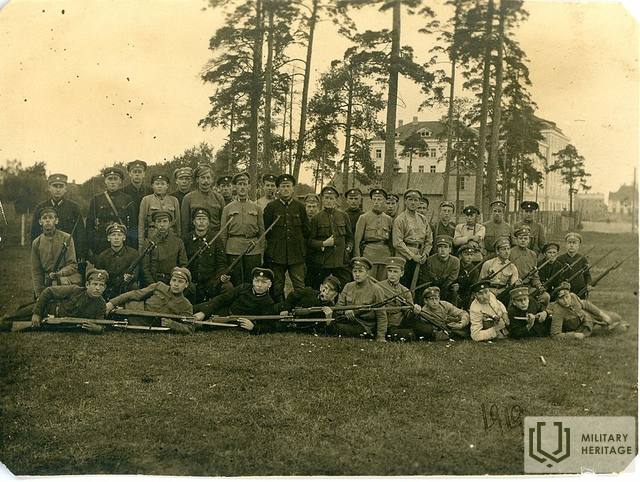
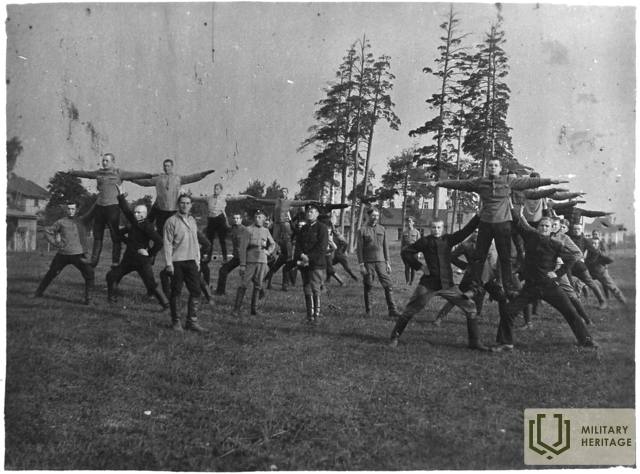

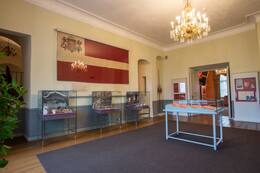
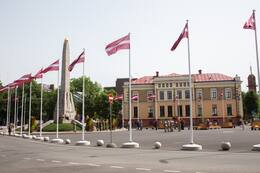
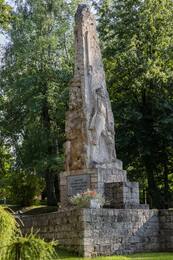
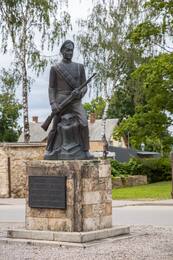
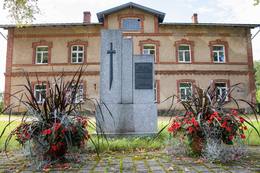
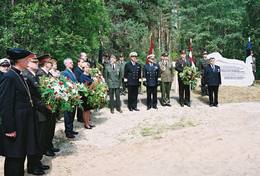
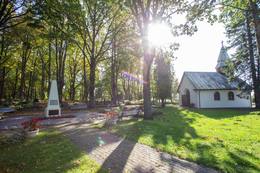
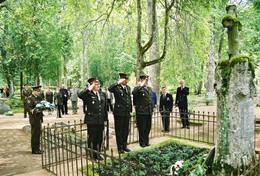
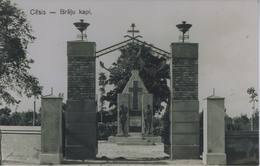
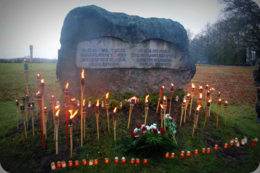
![Limbažiai. Prezidentas J. Čakste atidengia paminklą Limbažiuose žuvusiems Pirmajame pasauliniame kare. Latvijos Laisvės Kovos Paminklo atidengimas [1923]. Šaltinis: Latvijos nacionalinės bibliotekos skaitmeninė kolekcija „Dingusi Latvija“.](/g/Poi/00403/44213.png?size=260)
